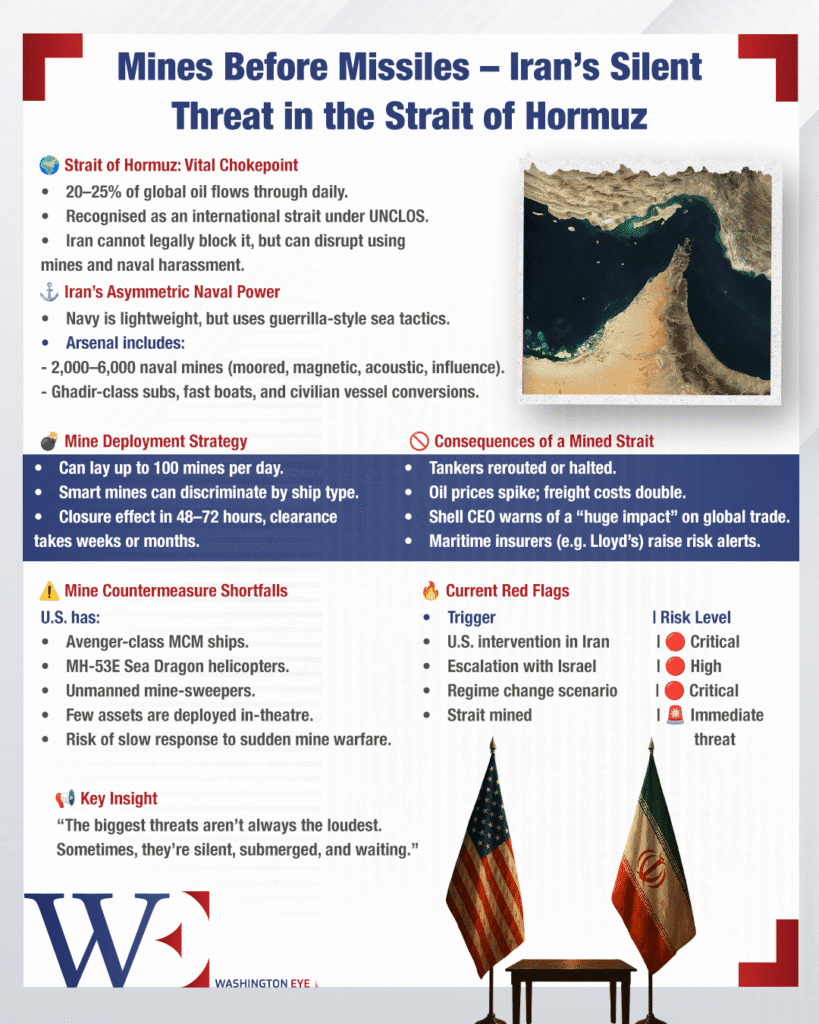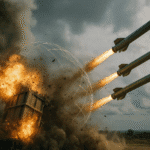In the escalating war between Israel and Iran, much of the world’s attention is fixed on missiles, drones, and headline-grabbing airstrikes. But the greatest threat to global stability may not come from the skies—it may be lurking silently beneath the waves of the Strait of Hormuz. With nearly a fifth of the world’s oil passing through this narrow waterway, the prospect of its closure isn’t just a regional concern—it’s a global crisis in the making.
As tensions rise, particularly with the potential for direct U.S. involvement or renewed calls for regime change in Tehran, the possibility of Iran mining the Strait has shifted from hypothetical to dangerously real. The consequences would be catastrophic, sending oil prices soaring, crippling maritime trade, and igniting a broader conflict no one is prepared for.
The Chokepoint That Holds the World Hostage
Legally, under the United Nations Convention on the Law of the Sea (UNCLOS), the Strait of Hormuz is classified as an international strait. This designation guarantees transit rights to all ships, including military vessels, regardless of the coastal state’s objections. Iran, notably, has not ratified UNCLOS—but international law doesn’t bend easily, and transit rights through the Strait have become customary global norms.
Yet legality often takes a back seat to strategy when geopolitical stakes are high. Iran has long claimed it can shut the Strait, and while a full naval blockade would provoke an immediate international backlash, Tehran doesn’t need to send in destroyers or pick a conventional fight with the U.S. Fifth Fleet. Instead, it can sow chaos more discreetly—and effectively—with sea mines.
Iran’s Asymmetric Naval Strategy
Iran’s navy is modest by conventional standards, but that’s precisely why it doesn’t fight like a conventional force. It excels in asymmetric warfare, combining speedboats, midget submarines, drone swarms, and yes—thousands of mines.
Estimates suggest Iran has stockpiled anywhere between 2,000 and 6,000 naval mines, including acoustic, magnetic, and pressure-triggered devices. These aren’t relics of past wars either—many are smart mines, capable of identifying and selecting targets based on acoustic signatures. And Iran’s Ghadir-class submarines or even disguised civilian vessels could deploy them with minimal warning. With the ability to lay up to 100 mines per day, Iran could severely restrict maritime traffic through Hormuz in just a few days.
And mine-clearing? That takes time—often weeks or months, depending on the scale and sophistication of the threat. During that window, oil tankers and container ships would be rerouted or halted altogether, leading to severe global supply chain disruptions.
Where Are the Minehunters?
The U.S. Navy has invested in mine countermeasure capabilities—dedicated Avenger-class ships, MH-53 helicopters, and newer unmanned surface vessels. But despite decades of naval presence in the Gulf, the actual number of U.S. minehunters deployed in-theatre remains limited.
That’s a dangerous oversight.
Mine warfare doesn’t require a blue-water navy or expensive missile systems. It’s low-tech, cost-effective, and ideally suited to a country like Iran that prefers to exploit choke points and asymmetric vulnerabilities. While U.S. naval power is unmatched on paper, its ability to respond quickly and effectively to a sudden mining of the Strait is questionable. Without adequate forward-deployed mine countermeasure forces, America—and the world—would be playing catch-up.
Not Just Threats—Real Intentions
Iran’s threats to close Hormuz aren’t just rhetorical. In 2011, then Vice President Mohammad Reza Rahimi warned that “not a drop of oil will pass through” the Strait if sanctions were enforced. Similar threats have resurfaced in recent months, particularly as Israel’s war against Hamas deepens, and as international observers warn that a broader regional war is brewing.
Iran’s doctrine of “strategic deterrence” is built on this layered response: if the regime is cornered—economically, militarily, or diplomatically—it responds in ways that are hard to predict and harder to counter. Closing Hormuz through mines would not only disrupt U.S. and Israeli supply lines, it would send global energy markets into panic.
Indeed, shipping costs have already begun to climb. Lloyd’s of London and major insurance firms are raising risk ratings for ships operating near Iranian waters. Some have even advised rerouting around the Strait—a logistical and financial nightmare. Shell’s CEO recently warned of a “huge impact on global trade” if the waterway is disrupted. The message is clear: this isn’t a distant threat. It’s a present one.
A War Below the Surface
The West, particularly the U.S., needs to reassess its naval posture in the region. Mine countermeasure assets must be forward-positioned, integrated with allies, and ready to respond at a moment’s notice. Deterrence must involve more than carrier strike groups—it must include the often-overlooked tools of maritime security: sonar arrays, autonomous mine-sweepers, and maritime domain awareness.
At the same time, policymakers must recognise that any push toward regime change in Iran—whether overt or covert—risks triggering the very crisis they hope to avoid. Hormuz isn’t just a line on a map. It’s a global artery. And all it takes to block it is a few well-placed mines and a slow international response.
If there’s one lesson from recent maritime conflicts, it’s this: the biggest threats aren’t always the loudest. Sometimes, they’re silent, submerged, and waiting.















